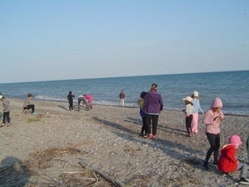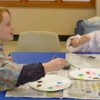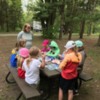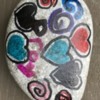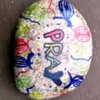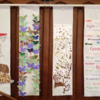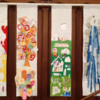the perfect Art Lessons, Ideas, Activities, and Resources for the Lord's Prayer
Post your Sunday School Art, Textile lessons, ideas, activities, and resources for the Lord's Prayer.
- Please include a scripture reference, supply lists, sources, suggested age range. age modification, etc.
- Photos are much appreciated! Click "attachments" and upload to your post.
- Please be careful not to post copyrighted materials. Excerpting and paraphrasing is okay. Include attribution.
Lord's Prayer - Matthew 6:9-13, Luke 11:1-13, Our Father, who art in heaven, Kingdom come, How to pray, etc.
Bible lessons and ideas about the Lord's Prayer -with Art, craft, painting, construction, drawing, etc.
The Lord's Prayer
Art Workshop
Summary of Lesson Activities:
Decorate prayer rocks and children will receive a copy of "The Prayer Rock Poem."
Scripture Reference:
Matthew 6:9-13, Luke 11: 1-4
Key Verse:
The Lord's Prayer
Workshop Objectives — After completing this Rotation, participants will be able to:
- Name that the story is found in the New Testament. Identify the four Gospels.
- For 3rd grade and up: Locate the story in Matthew and in Luke.
- Define prayer as a means of growing a personal relationship with God: talking and listening to God – any time, any place, and about any thing.
- Retell the story in his/her own words of the disciples asking Jesus to teach them to pray, and Jesus’ response, known as the Lord’s Prayer.
- Describe the Lord’s Prayer as universal, spoken in languages around the world, uniting Christians in their faith.
- Discuss the meaning of portions of the Lord’s Prayer.
Supplies:
- Easel; easel paper & appropriate makers; Sticky-Tack to hang paper
- Bibles
- Copies of the Lord’s Prayer on “scroll paper” (to hand out at end)
- One rock per student (each about 2 by 2 and 1/2 to 3 inches, light colors are best)
- The pray rock poem (one per student) - see end of lesson
- Paper towel, one sheet per student, permanent marker
- Acrylic paint in a variety of colors including primary colors and at least one bottle of white and one of black (Opaque colors will show up best.)
- Small containers for water – one for every 2 students
- Paint brushes - 3 per student
- Paper plates – one for every 2 students
- Table covering to protect tables
- Scratch paper and pencils (optional)
Leader Preparation:
- Read the scripture for this lesson.
- Read and reflect on the overview material provided for this lesson.
- Gather the above materials.
Before Start of Class:
- Wash the rocks and allow plenty of time for them to dry.
- Write in large letters, the Lord’s Prayer on a piece(s) of easel paper and post it on the wall where it can be seen.
- Spread the table covers over the tables.
- For 3rd grade and up: distribute Bibles around the tables. Write on the easel “Luke 11:1” and “Matthew 6:9”
- Fill water containers half full. Prepare one cup for every 2 students.
- Prepare paint palettes – one for every 2 students and set aside. To prepare: Shake paints and place a quarter-sized squirt of red, yellow and blue paint distributed on a paper plate. Also place a dime-sized dollop of white and of black. Hold-off on other colors for now.
- Have other supplies ready but set aside.
- Bookmark the division between the Old and the New Testament. Also bookmark Matthew 6:9 and Luke 11:1
Lesson Plan
Opening – Welcome & Lesson Introduction:
Greet your students warmly, introducing yourself and any other adults.
[Note: The Shepherd will be taking care of attendance, nametags, and any visitor cards. This can all happen quietly while you are starting your lesson.]
Say: This month we are learning about the Lord’s Prayer. [After the second week instead ask: What are we learning about this month?] Today we are going to make prayer rocks that will help us remember to pray. You can each decorate one rock with paint. Let’s start with prayer.
Ask for any prayer requests. Ask students to say their name and then their request. [It is okay if you write these down.] Ask if anyone would like to help you say a prayer. Use the Lord’s Prayer as the ending. A prayer suggestion: “God, Thank you for teaching us how to talk to you in different ways. May we pray to you with our whole hearts, giving thanks for all of the wonderful blessings you have given to us.” (Pray for requests. End with the Lord’s Prayer.) Amen.
Dig - Main Content & Reflection:
Ask: When you think of prayer, what comes to mind? (allow a few answers)
Say: Prayer is talking and listening to God. Prayer is communicating with God.
Ask: What is the Lord’s Prayer? (a prayer we say together in church)
Why do we call it “the Lord’s Prayer”?
Say: We call it the “Lord’s Prayer” because Jesus taught it to the disciples. Jesus and God are often called “Lord.” Let’s read in the Bible about Jesus teaching his disciples to pray.
Ask: Since this is a story about Jesus, where would we find it – in the Old Testament or the New Testament of the Bible? (in the New Testament)
Do: As you say the next words, show the portions of the Bible that are the OT and the NT.
Say: The Bible contains two Testaments or two major sections – the Old Testament and the New Testament. The New Testament includes stories about Jesus.
Ask: What do we call the part of the New Testament where we find the stories about Jesus? (the Gospels)
Say: The word “Gospel” means “good news.” The first four books of the New Testament tell the story of the good news about Jesus. It is indeed good news that Jesus taught us how to pray.
For 3rd through 6th graders:
Do: Make sure that everyone has access to a Bible.
Ask: What are the names of the four gospels?
Can anyone tell me in which Gospels we find our story? (Matthew and Luke)
Do: If necessary, teach them the quick way to find the New Testament. [1]
Do: Have everyone count off “1-2.” Have all of the “1’s” find Luke 11:1 and the “2’s” find Matthew 6:9. (Refer to the easel.)
Say: Follow along as I read these passages to you. I will start with Luke.
Do: As you reading the passage in Luke, ask everyone who has found Matthew, to look at a neighbor’s Bible. Read Luke 11:1-2a [Luke: 11:2a = “He said to them, ‘When you pray, say.”]
Do: Then have those who found Luke switch to look at a neighbor’s Bible while you read Matthew 6:9b-15. [Matt 6:9b = “Our Father in heaven…”]
[1] Opening the Bible in middle lands you usually in Psalms. Taking just the back half and finding middle of that, gets you to beginning of NT.
For 1st and 2nd grade:
Say: Jesus teaching his disciples how to pray is found in the book of Matthew and Luke in our Bible. Listen as I read to you from the Bible in the Gospels of Luke and Matthew.
Do: Read Luke 11:1-2a and Matthew 6:9b-15. [Luke: 11:2a = “He said to them, ‘When you pray, say.” Then continue reading with Matt 6:9b = “Our Father in heaven…”]
For all students - Initial Discussion:
Ask: Have you ever heard that prayer during the worship service?
Say: What we say as the Lord’s Prayer is slightly different than what I just read. We will talk some more about the Lord’s Prayer as we paint our prayer rocks.
Ask: I wonder what a rock has to do with prayer? (accept a few replies)
Say: Let me read to you a poem that you can take home with your prayer rock.
Do: Read the prayer rock poem. (See end of lesson.)
Say: We can call these our pillow prayer rocks! It sounds like a fun way of being reminded to pray. Let’s start our art project: painting our pillow prayer rocks. You may decorate your prayer rock in whatever way that you’d like. Because paint takes time to dry, you’ll only be able to decorate one side of your rock.
Do: Distribute to each child a sheet of newspaper, a piece of scrap paper, a pencil, and a paper towel.
Say: I am handing out some scrap paper in case you want to doodle some ideas for what to paint on your rock. The Shepherd(s) will be coming around a writing your name on the piece of paper towel. We also have paint smocks to wear.
Do: Distribute paint smocks. Show them the supplies they can use. Explain how every two students will be sharing a palette of paint. Distribute six paintbrushes with each palette. Point out how time will be saved if each brush is used for one color on the palette (less washing of brushes).
Do: Distribute one rock per student. Ask them to work with their rock on the paper towel.
Art tips:
- Encourage imagination. (Imagination is that part of your brain that allows you to see animals and funny faces in the passing clouds!)
- Light pencil sketching on the rock is okay.
- Several thin coats of paint are better than a gloppy, thick coat (although each coat should dry before applying another coat – use the hairdryer.)
- Avoid trying to use the paintbrush to “sketch” (i.e., lifting the tip as you make short strokes). Instead, place a loaded brush on the rock and pull out gently but firmly. This gives better control. (Demonstrate this on the easel with a dry brush).
- To create straight lines hold the brush nearly perpendicular (“straight up and down" to the rock). Suggest testing out brush strokes on the newspaper.
- “Big to little.” Paint in the large areas first.
- Encourage creating more colors on the “palette” (the plate) by mixing colors. Add white paint to make a lighter color, black to make a darker color. If students would like other colors you may offer them.
- Add details: Outlining with a different color can help to highlight and create depth. Darker and lighter shades provide contrast. (However paint should be dried before another color is added on top or next to – use the hairdryer)
Discussion: (work in these questions while the kids make their projects)
[Note: Some banter between students about off-topic material is ok however don’t miss what is an opportune time as the students work! It is the story discussion that can prompt God’s character to be revealed.]
Say: While you work I am going to ask you some questions about prayer. We had described prayer as a way of communicating with God.
Ask: Why do you suppose we would want to communicate with God? (accept replies)
 Say: Prayer makes our relationship with God stronger!
Say: Prayer makes our relationship with God stronger!
Ask: How do you get to have a close relationship with a friend – like if you have a really good friend – how did you become close friends?
Say: That’s right, to become close friends you had to spend time together, you did things together including talking and listening. God really wants to have a close relationship with us! He wants very much to hear what is on our minds.
Ask: Can you imagine trying to have a best friend without talking with them?
Say: So prayer is communicating with God. We may not be able to call God on the telephone or send him a letter, but prayer is just as real as an email. God hears us!
Do: Tell a story about a time when you felt that God heard your prayer.
Ask: Can you pray when you are happy? What about when you are sad, or in trouble? What about when you are mad?
Say: We can pray to God anytime and about anything!
Ask: Do you suppose that there are Christians who read the Bible in name the closest town to yours? What about in name a near by state? In Canada? In South America? In Germany? In Africa?
Say: If people read the Bible all over the world then they’ve heard about Jesus teaching us to pray! That is amazing isn’t it – the Lord’s Prayer is said all over the world! That really brings Christians all around the world together!
Ask: I am wondering if anyone can ask me a question about what parts of the Lord’s Prayer that they maybe don’t understand? (Use the Bible Background materials to help you answer questions. You may need to prompt the questions by asking one yourself.)
If you have extra time:
Have students add detail to their work. See painting tips above.
Have students share their work with the class, explaining about their choices.
Closing:
Say: Use your prayer rock to remind you to talk to God in prayer.
Do: Read the prayer rock poem again.
Say: God loves you. God would like very much to hear your prayers.
Do: Hand out a copy of the prayer rock poem and (if students have not yet received one) a copy of the Lord's Prayer.
The Prayer Rock poem:
(source unknown)
I’m your little prayer rock and this is what I’ll do.
Just put me on your pillow ‘till the day is through.
Then turn back the covers and climb in your bed.
And “WHACK” -- your little prayer rock will hit you in the head.
Then you will remember as the day is through,
to kneel and say your prayers as you wanted to.
Then when you are finished, just dump me on the floor.
I’ll stay there through the night to give you help once more.
When you get up in the morning, “CLUNK”, I’ll stub your toe.
So you will remember your morning prayers before you go.
Put me back upon your pillow when your bed it made.
Your clever little prayer rock will continue to be your aid.
Because your heavenly Father cares and loves you so.
He wants you to remember to talk to him, you know.
- Lake, Jane. “How to Paint a River Rock.” 2010. <http://www.allfreecrafts.com/nature/river-rocks.shtml>.
- MacQueen, Neil. “Lord’s Prayer – Lesson Outlines.” Rotation.org. 2001.
- Marshall, Jan. “The Lord’s Prayer Lesson Set.” Rotation.org. 2002.
- Welford, Lin. Rock Painting Fun for Everyone! Green Forest, AR: ArtStone, 2006.

Other resources: Visit Carol's blog – where we encourage parents to continue the learning at home. (Conflict of Interest Disclosure: None. Carol does not make any money from her blog. Any ads you see are placed there by Wordpress.)
Comments from others on making prayer rocks:
from Neil MacQueen
- Worked great. I was really surprised how well the older ones enjoyed making the rocks.
- IMPROVEMENT MODIFICATION: We used hairspray to give sheen and "set" the colored markers we used on the rocks.
- Loved this!
We did it at our girl's (ages 7-9) spring camp at the local provincial park. On the Friday evening we went on a scavenger hunt, the girls searched for their perfect "light gray colored" rock at the park's lake beach.Saturday morning after breakfast we decorated them. We used permanent Sharpie markers and sealed them with Gloss Decoupage Glue (the bottle indicated it would work on most things and it did!). They decorated both sides, one around the word "Pray" and the other around their name.
Only had to wait a couple of minutes for the marker art work to dry, then I went around the table and simply squeezed a few drops of glue right from the bottle directly onto their stone drawing and they used a foam brush to spread it thinly over the top and sides. A few minutes later they flippedthem over and I dropped glue onto the other side and again they smoothed the drops over their rock. The marker never smeared.
They glue dried really quickly. We also gave the girls a laminated mini copy of The Prayer Rock Poem and a small baggie to store them in. Here is a link to a pdf of The Prayer Rock Poem (6 per page) you can print and laminate.
A lesson written by Carol Hulbert from
First United Methodist Church
120 S. State Street Ann Arbor, MI 48104
Copyright 2002, 2013 First United Methodist Church, Ann Arbor, MI. Permission to copy materials granted for non-commercial use provided credit is given and all cited references remain with this material.

